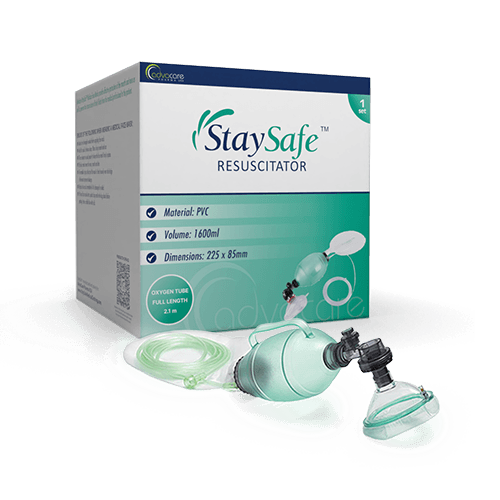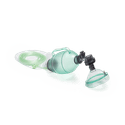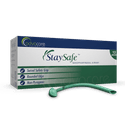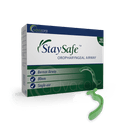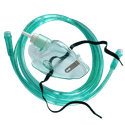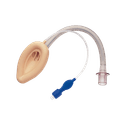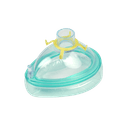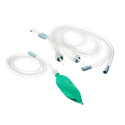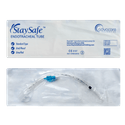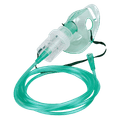Resuscitator
Components
Material
Reservoir Bag Volume
Pressure Relief Valve
Size
Packaging
What is a Resuscitator?
A Resuscitator is a medical device used to provide temporary respiratory support and assist with ventilation, such as during cardiopulmonary resuscitation (CPR) or for supporting patients experiencing respiratory distress. It is used in hospitals, clinics, and ambulances, including pre-hospital and emergency care.
A resuscitator is also known as a manual resuscitator, bag-valve-mask (BVM), or "self-inflating bag".
The resuscitator consists of four components: the oxygen reservoir bag, a mask, a 2.1m oxygen tube, and a valve. The self-inflating bag is connected to the face mask and then manually operated by a healthcare professional. The individual squeezes the bag in order to deliver a controlled flow of oxygen to the patients lungs and assist with the intake and expulsion of air.
Resuscitators are manufactured from silicone, liquid silicone, SEBS, or PVC and are available in sizes for infants, children, or adults. The reservoir bags are available in a volume of 1600ml or 2000ml and with a pressure relief valve of 40cm H20 or 60cm H20.
Resuscitators are manufactured by AdvaCare Pharma in facilities located in China, India, and the USA. These factories strictly adhere to the rigorous regulations required for CE/ISO certification, ensuring our medical products highest quality, safety, and efficiency.
Product Specifications
Components
Oxygen Reservoir Bag is a transparent collapsible bag used for positive pressure ventilation. It is made of a flexible material.
The oxygen reservoir bag is available in various sizes to accommodate patients of different age groups, ranging from infants to adults.
The reservoir bag is an essential component of respiratory systems, as it provides a reservoir of oxygen to ensure adequate ventilation and oxygenation during a medical procedure or emergency.
Mask is used to cover the patient's nose and mouth. It is available in different sizes depending on the patient's needs, from infant sizes to adult sizes. The mask is usually made of a soft, flexible material and has a cushion to ensure a good seal against the patient's face.
Oxygen Tube is a 2.1 meter tube that connects the valve to the mask and bag, which enables the administration of oxygen or air to the patient. This flexible tube is designed to deliver a continuous flow of oxygen. It provides a crucial connection that facilitates the transfer of oxygen or air from the oxygen source to the patient's respiratory system.
Valve is used to regulate the flow of oxygen or air into the bag and to prevent airflow back into the device during exhalation.
It is an essential component in the oxygen delivery system and is responsible for regulating the flow of gas into the bag and ensuring efficient respiratory support.
Material
Silicone is a flexible and durable synthetic material that is resistant to high temperatures and UV rays, which makes it ideal for use in high-stress environments. Silicone bag valve masks (BVMs) are soft and flexible, helping to create a good seal against the patient's face. The easy-to-clean nature of silicone ensures proper hygiene and reduces the risk of contamination.
Liquid Silicone, also known as LSR (liquid silicone rubber), is a form of silicone used to create a more uniform, flexible, and durable bag valve mask (BVM) than traditional silicone. Liquid silicone is typically used in injection molding, allowing more precise control over the shape and size of the BVM.
Styrene-Ethylene-Butylene-Styrene (SEBS) is a type of thermoplastic elastomer. It is a highly flexible material that can be easily molded into complex shapes. SEBS is also hypoallergenic, making it suitable for patients with latex allergies or sensitivities. SEBS is an ideal choice for use in safe and efficient bag valve masks (BVMs) disposable resuscitators.
Polyvinyl Chloride (PVC) is a thermoplastic polymer that is a lightweight and flexible material. It is a cost-effective material that is known for its versatility. It is important to note that PVC should not be heated as it can release potentially harmful chemicals. Proper safety guidelines should be consulted to properly care for PVC materials.
Why are we a quality Resuscitator manufacturer?
AdvaCare Pharma is an American-owned and operated company specializing in medical supplies for respiratory use. We manufacture Resuscitators and our entire StaySafe™ medical disposables range under strict international guidelines at one of our CE and ISO-certified facilities.
Our distributors have confidence in the quality and reliability of our products, making AdvaCare Pharma a leading supplier in countries where dependable medical supplies and pharmaceuticals are highly sought after. For the past 20 years, we have established a reputation as a trusted supplier of medical products in 65 countries.
Uses
What is a Resuscitator used for?
It is used to provide manual ventilation to a patient with respiratory distress or failure.
How is a Resuscitator used?
To use a resuscitator, the healthcare provider manually squeezes the bag to deliver a controlled flow of oxygen into the patient's lungs. The mask or facepiece is placed over the patient's nose and mouth to create a seal, and the bag is compressed and released to deliver breaths. This process helps supply oxygen and support breathing until more advanced interventions can be initiated.
Are there any special storage instructions for Resuscitators?
It is advised to keep any unused resuscitators away from direct sunlight, extreme temperatures, and contaminants. The items should be kept in their original packaging or a suitable storage bag to protect them from damage.
How should used Resuscitators be disposed of?
Any used resuscitators should be considered potentially infectious and handled with the appropriate precautions. It is recommended to dispose of used resuscitators in accordance with local regulations and the institutional guidelines for medical waste disposal.
FAQs
What type of material should be chosen for the Resuscitator?
When choosing the material for a resuscitator, it is important to consider patient comfort, durability, compatibility with sterilization methods, and compliance with regulatory guidelines. Silicone resuscitators are popular due to their softness, flexibility, and ability to create a good seal during ventilation. They are durable, compatible with sterilization methods, and often preferred for reusable devices.
Liquid silicone offers similar benefits but can provide enhanced control. SEBS resuscitators offer flexibility, good elasticity, and a secure fit during ventilation, and they are suitable for those with latex allergies. PVC resuscitators are cost-effective, rigid, and transparent for easy monitoring of the patient's condition.
What is the difference between the types of pressure relief valves?
The difference between the pressure relief valves lies in the level of pressure at which they open to release excess pressure during resuscitation. The pressure relief valve set at 40cm H2O will start to release excess pressure when it reaches or exceeds 40cm H2O; however, a 60cm H2O valve will open at or above 60cm H2O.
What size of reservoir bag should be used?
A 1600ml reservoir bag is typically suitable for standard ventilation requirements and can meet the needs of most patients. A 2000ml reservoir bag offers a larger capacity for situations requiring higher tidal volumes or extended periods of ventilation.
Are there services available to assist with regulatory requirements when importing your Resuscitators?
Yes, we offer tailored regulatory support to distributors for complying with local regulations during the importation of our medical devices. With our proficient Regulatory Affairs Department, comprising pharmacists, biomedical engineers, QA professionals, and documentation specialists, we ensure efficient product registration.

You might be interested in...
Why AdvaCare Pharma?
As an industry leader, we are aware of our responsibility to provide affordable and sustainable solutions to improve healthcare worldwide.
